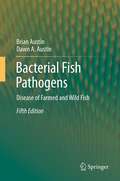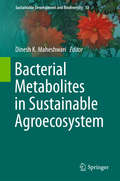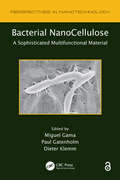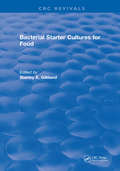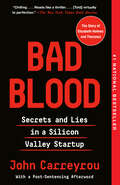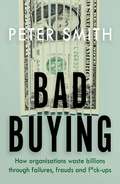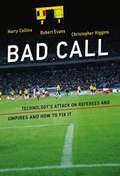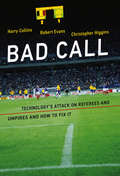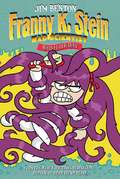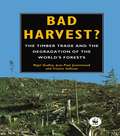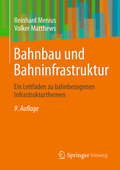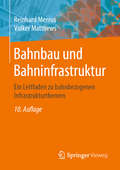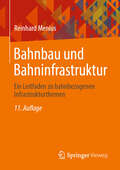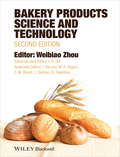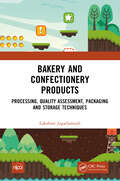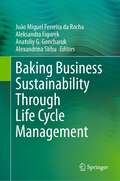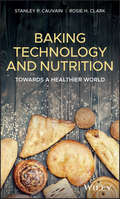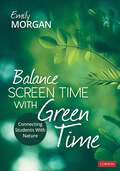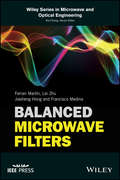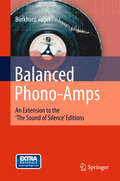- Table View
- List View
Bacterial Fish Pathogens: Disease of Farmed and Wild Fish (Springer Praxis Books / Aquaculture And Fisheries Ser.)
by Dawn A. Austin Brian AustinThis completely updated fifth edition of Bacterial Fish Pathogens is a comprehensive discussion of the biological aspects of the bacteria which cause disease in farmed and wild fish. Since the 4th edition was published in 2007, there has been an upturn in the application of molecular approaches to taxonomy, diagnosis and vaccine development. New pathogens, e.g. Aeromonas schubertii, have been described. Also, there has been the emergence of diseases caused by bacteria which have not been cultured, and which have been equated with new taxa, i.e. 'Candidatus'. Consideration is given to all the bacterial fish pathogens, including primary pathogens and opportunists.
Bacterial Metabolites in Sustainable Agroecosystem (Sustainable Development and Biodiversity #12)
by Dinesh K. MaheshwariThere has been a resurgence of interest in environmental friendly, sustainable and organic cultural practices that warrants high yield and quality in agricultural crops. To enhance sustainable agricultural production and alleviate food scarcity, spoor of majority of microorganisms, especially plant growth and health promoting bacteria of eminent characteristics that allow them for exploitation in agro-ecosystem. Plant growth promoting rhizobacteria are the soil bacteria inhabiting around/on the root surface and are directly or indirectly involved in promoting plant growth and development via production and secretion of various regulatory chemicals in the vicinity of rhizosphere. Among various beneficial bacteria mediated mechanisms include direct production of phytohormones and biosurfactants experiencing quest of research and concept up gradation that can built emerging paradigm (agriculture model). Research on bacteria-mediated phytohormones is crucially important, provides key understanding of the plant growth and development. Various genera including PGPR group of bacteria are potential source of plant growth regulators. Application of such organism allow plants to survive under abiotic and biotic stress conditions besides govern phytohormone mediated immune response and manage to regulate hormones. Such group of bacteria also produce another important metabolite i. e. biosurfacatants which are involved in many important functions to bacteria itself as we ll as for the plants and their ecosystem. Biosurfactants may alter nutrient availability, endogenous metabolites such as antibiotics production, root colonization imparting protection from phytopathogens besides eradicating soil contaminants and other pollutants. The role and activities of surfactants produced by bacteria are multifarious in nature. Thus, bacterial phytohormones and biosurfactants are identified as effector molecules in plant- microbe interactions, in pathogenesis and phyto-stimulation which can either be beneficial for the bacteria itself or for the crops. This book highlights current applications and research on bacterial hormones and surfactants to provide a timely overview. The chapters have been contributed by subject experts from around the world and include topics of varied importance which include phytohormones production by rhizospheric and endophytic bacteria, their role in rhizosphere competence, plant growth regulation, bioremediation, biosurfactants as antibiofilm agents and other aspects. This major new work represents a valuable source of information to all those scientists interested in microbial technology with respect to the microbial innovative products and applications towards sustainable agroecosystem.
Bacterial NanoCellulose: A Sophisticated Multifunctional Material (Perspectives In Nanotechnology Ser. #9)
by Miguel GamaThe first book dedicated to the potential applications and unique properties of bacterial cellulose (BC), this seminal work covers the basic science, technology, and economic impact of this bulk chemical as well as the companies and patents that are driving the field. It reviews the biosynthesis and properties of BC, including genetics and characterization; discusses the advancing technology as it relates to product development, bioreactors, and production; and analyzes the economic impact of BC on a diverse range of industry applications, including materials and biomaterials, biological and polymer sciences, and electromechanical engineering.
Bacterial Starter Cultures for Food
by Stanley E. GillilandThis book brings together information concerning starter culture bacteria in the manufacture of many milk, meat, vegetable, and bakery products. The characteristics and functions of these bacteria in the production of cultured foods, as well as factors which affect their performance, are discussed in detail. Topics include the role of plasmids in starter culture bacteria, the function of these bacteria as food preservatives, nutritional and health benefits, and future applications. Authors provide historical background as an introduction to each chapter. This will be a valuable reference book for food industry technologists and academicians.
Bacterial Volatile Compounds as Mediators of Airborne Interactions
by Birgit Piechulla Choong-Min Ryu Laure WeisskopfThis book covers the fundamentals of bacterial volatile-mediated communication with other organisms, starting with the biosyntheses of volatile organic compounds (VOC), interactions with plants and animals, interactions with microbes, tools for data analysis, and their applications. With this foundation in place, the book subsequently focuses on understanding the effect of bacterial volatiles on plant growth promotion, discusses plant immunity, and lastly shares insights into future research directions. The book is divided into fourteen-in-depth chapters, each of which is designed to enrich readers’ understanding of bacterial volatile compounds’ functions and various applications.The pivotal roles of bacterial volatile compounds make this book essential reading for scientists and students of all biological disciplines seeking to fully understand microorganism responses and environmental adaptations. In addition to its value as a fundamental book for graduate students, it offers a clearly structured reference guide for all individuals working in microbiology.
Bacteriocins
by Qing GuThis book intends to report the new results of the study of bacteriocins, from basic research to application fields. It mainly introduces the biological characteristics of bacteriocins, the relationship between their structure and function, the antibacterial mode of action, and their application as antibacterial agents in food industry, medical care, and other areas, especially their application potential in human health. This book can be used as a reference book for researchers, undergraduates, and graduated students in the professional fields of food science and engineering, bioengineering, medicine, and agriculture.
Bad Blood: Secrets and Lies in a Silicon Valley Startup
by John Carreyrou<P>The full inside story of the breathtaking rise and shocking collapse of Theranos, the multibillion-dollar biotech startup, by the prize-winning journalist who first broke the story and pursued it to the end, despite pressure from its charismatic CEO and threats by her lawyers. <P>In 2014, Theranos founder and CEO Elizabeth Holmes was widely seen as the female Steve Jobs: a brilliant Stanford dropout whose startup "unicorn" promised to revolutionize the medical industry with a machine that would make blood testing significantly faster and easier. <P>Backed by investors such as Larry Ellison and Tim Draper, Theranos sold shares in a fundraising round that valued the company at more than $9 billion, putting Holmes's worth at an estimated $4.7 billion. <P>There was just one problem: The technology didn't work. <P>A riveting story of the biggest corporate fraud since Enron, a tale of ambition and hubris set amid the bold promises of Silicon Valley. <P><b>A New York Times Bestseller</b>
Bad Buying: How organisations waste billions through failures, frauds and f*ck-ups
by Peter Smith"A fascinating litany of the mistakes that can happen when buyers get it wrong" - Luke Johnson, The Sunday Times"Packed full with amazing examples' Jeremy Vine, BBC Radio 2"Colossal, costly disasters could be averted if those holding the purse strings read this book. - The TimesIn this hilarious, fascinating and insightful expose, industry insider Peter Smith reveals the massive blunders and dodgy dealings taking place around the world as private companies and public sector bodies buy goods and services. A recent report showed that over 90% of procurement projects fail. So, why are so many billions wasted on ineptitude, mismanagement and, in some cases, fraud? By turns an entertaining account of some of the worst procurement scams in history and also a resounding lesson in how not to operate, Bad Buying offers clear and practical advice on how to avoid embarrassing mistakes, minimise needless waste and make sound, strategic procurement decisions on your next initiative.'Had this been published pre-Covid, some of the recent f*ck-ups and waste might have been avoided. It's a must read for the public and private sector alike' Lt-Gen. Sir Andrew Gregory, SSAFA: The Armed Forces Charity 'Hilarious, enlightening and brilliant....This book will make you think twice about buying anything - but do buy this' Antonio Weiss, bestselling author of 101 Business Ideas That Will Change the Way you Work, and Director, The PSC
Bad Call: Technology's Attack on Referees and Umpires and How to Fix It
by Robert Evans Harry Collins Christopher HigginsGood call or bad call, referees and umpires have always had the final say in sports. Bad calls are more visible: plays are televised backward and forward and in slow motion. New technologies -- the Hawk-Eye system used in tennis and cricket, for example, and the goal-line technology used in English football -- introduced to correct bad calls sometimes get it right and sometimes get it wrong, but always undermine the authority of referees and umpires. Bad Call looks at the technologies used to make refereeing decisions in sports, analyzes them in action, and explains the consequences.Used well, technologies can help referees reach the right decision and deliver justice for fans: a fair match in which the best team wins. Used poorly, however, decision-making technologies pass off statements of probability as perfect accuracy and perpetuate a mythology of infallibility. The authors re-analyze three seasons of play in English Premier League football, and discover that goal line technology was irrelevant; so many crucial wrong decisions were made that different teams should have won the Premiership, advanced to the Champions League, and been relegated. Simple video replay could have prevented most of these bad calls. (Major League baseball learned this lesson, introducing expanded replay after a bad call cost Detroit Tigers pitcher Armando Galarraga a perfect game.)What matters in sports is not computer-generated projections of ball position but what is seen by the human eye -- reconciling what the sports fan sees and what the game official sees.
Bad Call: Technology's Attack on Referees and Umpires and How to Fix It (Inside Technology)
by Robert Evans Harry Collins Christopher HigginsHow technologies can get it wrong in sports, and what the consequences are—referees undermined, fans heartbroken, and the illusion of perfect accuracy maintained.Good call or bad call, referees and umpires have always had the final say in sports. Bad calls are more visible: plays are televised backward and forward and in slow motion. New technologies—the Hawk-Eye system used in tennis and cricket, for example, and the goal-line technology used in English football—introduced to correct bad calls sometimes get it right and sometimes get it wrong, but always undermine the authority of referees and umpires. Bad Call looks at the technologies used to make refereeing decisions in sports, analyzes them in action, and explains the consequences.Used well, technologies can help referees reach the right decision and deliver justice for fans: a fair match in which the best team wins. Used poorly, however, decision-making technologies pass off statements of probability as perfect accuracy and perpetuate a mythology of infallibility. The authors re-analyze three seasons of play in English Premier League football, and discover that goal line technology was irrelevant; so many crucial wrong decisions were made that different teams should have won the Premiership, advanced to the Champions League, and been relegated. Simple video replay could have prevented most of these bad calls. (Major League baseball learned this lesson, introducing expanded replay after a bad call cost Detroit Tigers pitcher Armando Galarraga a perfect game.)What matters in sports is not computer-generated projections of ball position but what is seen by the human eye—reconciling what the sports fan sees and what the game official sees.
Bad Hair Day (Franny K. Stein, Mad Scientist #8)
by Jim BentonFranny K. Stein is back with another laugh-out-loud experimental adventure in the eighth book in the Mad Scientist series from Jim Benton, the New York Times bestselling author-illustrator of Dear Dumb Diary and Happy Bunny.Franny K. Stein isn’t a fan of glamour. She doesn’t style her hair, the thought of wearing makeup makes her want to gag, and she couldn’t care less about wearing dressy dresses when she’d much prefer her lab coat. But sometimes Franny wonders if her mom wishes she were different. Which gives Franny an idea…for an experiment! What if she can turn the beauty products her mom loves into something more exciting? Every experiment has its experimental error, and when Franny’s hair takes on a life of its own, Franny must save the day (and her hair) to finally realize her mom loves her just the way she is.
Bad Harvest: The Timber Trade and the Degradation of Global Forests
by Jean-Paul Jeanrenaud Nigel Dudley Francis SullivanThe world's forests are disappearing at an alarming rate, and with disastrous consequences. Demand for wood and paper products ranks high amongst the causes of deforestation and forest degradation, and is now the major cause of loss in those forests richest in wildlife. There is a great deal to be done to improve the timber industry before our forests are safely and sustainably managed. Bad Harvest presents an incisive account of the role that the timber trade has played in the loss and degradation of forests around the world. It examines the environmental consequences of the trade on boreal, temporal and tropical regions, and its impacts for local people working and living in the forests. It also looks at the changing nature of the trade, and assesses current national and international initiatives to address the impacts of deforestation. Finally, the authors show how things could be improved in the future, by presenting a new strategy for sustainable forest management. Based on 15 years of extensive research - particularly work carried out by the World Wide Fund for Nature - Bad Harvest is essential reading on the subject; not only for environmentalists, but also for those in the timber trade seeking to improve the management and reputation of their product.
Badass Bricks: Thirty-Five Weapons of Mass Construction
by Jake MackayLEGO is fun. So are toy weapons. The only thing more fun is LEGO toy weapons! A compilation of badass brick weapons--some that actually even work--this book is designed for the adult brick enthusiast. Each project is original (i.e., not from a LEGO kit) and is accompanied by how-to schematics and full-color original photographs of the finished object. Dangerous and exciting projects include:TomahawkBroadswordClaymore (two-handed sword)Ninja throwing starM1911 pistolSiege towerGatling gunMK2 grenadeScythed chariotParis gunFlamethrowerAnd many more!Hobbyists love to make weapons, and this book goes far beyond the kits that are available to showcase forty projects for amazing weapons. The projects range from medieval to modern, from small hand grenades to an actual working guillotine to an assault amphibious vehicle. Badass Bricks will keep adults occupied for hours and is the perfect book for the adult brick enthusiast, weapons hobbyist, or all-around badass!
Bahnbau und Bahninfrastruktur: Ein Leitfaden zu bahnbezogenen Infrastrukturthemen
by Reinhard Menius Volker MatthewsDas Lehrbuch vermittelt anschaulich und praxisnah die bauspezifischen Grundlagen der Schienenbahnen und wendet sich prim#65533;r an Studierende im bautechnischen Hochschulbereich. Es ist eine wertvolle Erg#65533;nzung zu Vorlesungen und #65533;bungen. Dem Praktiker zeigt es, auf welchen Grundlagen z. B. bestimmte Trassierungsregeln beruhen. Neben technischem Know-how findet der Leser Themen wie Lichtraumprofile, Linienf#65533;hrung in Grund- und Aufriss, Querschnittsgestaltung, Unter- und Oberbau, Weichen und Kreuzungen, ausgew#65533;hlte Signale, Hinweise zu Bahnanlagen und Bahn#65533;berg#65533;ngen sowie zum Bauen unter Eisenbahnbetrieb und auch Grundlagen des Schienenverkehrsl#65533;rms. Der Autor bezieht sich schwerpunktm#65533;#65533;ig auf normalspurige Bahnen, also die klassischen Schienenbahnen. In der 9. Auflage wurde das von Prof. Dr. -Ing. Volker Matthews begr#65533;ndete Werk von Prof. Dipl. -Ing. Reinhard Menius weitergef#65533;hrt und komplett #65533;berarbeitet und aktualisiert.
Bahnbau und Bahninfrastruktur: Ein Leitfaden zu bahnbezogenen Infrastrukturthemen
by Reinhard Menius Volker MatthewsDas Lehrbuch vermittelt anschaulich und praxisnah die Grundlagen derSchienenbahnen und wendet sich primär an Studierende im bautechnischenHochschulbereich als wertvolle Ergänzung zu Vorlesungen und Übungen.Dem Praktiker zeigt es wesentliche Grundlagen und Zusammenhänge. DerAutor bezieht sich insbesondere auf normalspurige, klassische Bahnen. Abder 9. Auflage wurde das von Prof. Dr.-Ing. Volker Matthews begründeteWerk von Prof. Dipl.-Ing. Reinhard Menius weitergeführt, komplett überarbeitetund aktualisiert.
Bahnbau und Bahninfrastruktur: Ein Leitfaden zu bahnbezogenen Infrastrukturthemen
by Reinhard MeniusDas Lehrbuch vermittelt anschaulich und praxisnah die Grundlagen derSchienenbahnen und wendet sich primär an Studierende im bautechnischenHochschulbereich als wertvolle Ergänzung zu Vorlesungen und Übungen.Dem Praktiker zeigt es wesentliche Grundlagen und Zusammenhänge. DerAutor bezieht sich insbesondere auf normalspurige, klassische Bahnen. Abder 9. Auflage wurde das von Prof. Dr.-Ing. Volker Matthews begründeteWerk von Prof. Dipl.-Ing. Reinhard Menius weitergeführt, komplett überarbeitetund aktualisiert.
Bainite in Steels: Theory and Practice, Third Edition
by H.K.D.H. BhadeshiaThis is the third edition of the book, much expanded to include and incorporate important developments in the subject over the last fifteen years. The book represents a comprehensive treatise on all aspects of the bainite transformation, from the choreography of atoms during the phase change to length scales that are typical of engineering applications. The alloy design that emerges from this explains the role of solute additions, and the pernicious effects of impurities such as hydrogen. The picture presented is self-consistent and therefore is able to guide the reader on the exploitation of theory to the design of some of the most exciting steels, including the world’s first bulk nanostructured metal.
Bakery Products Science and Technology
by Y. H. Hui Weibiao ZhouBaking is a process that has been practiced for centuries, and bakery products range in complexity from the simple ingredients of a plain pastry to the numerous components of a cake. While currently there are many books available aimed at food service operators, culinary art instruction and consumers, relatively few professional publications exist that cover the science and technology of baking. In this book, professionals from industry, government and academia contribute their perspectives on the state of industrial baking today. The second edition of this successful and comprehensive overview of bakery science is revised and expanded, featuring chapters on various bread and non-bread products from around the world, as well as nutrition and packaging, processing, quality control, global bread varieties and other popular bakery products. The book is structured to follow the baking process, from the basics, flour and other ingredients, to mixing, proofing and baking. Blending the technical aspects of baking with the latest scientific research, Bakery Products Science and Technology, Second Edition has all the finest ingredients to serve the most demanding appetites of food science professionals, researchers, and students.
Bakery and Confectionery Products: Processing, Quality Assessment, Packaging and Storage Techniques
by Lakshmi JagarlamudiThis book is a comprehensive and practical day-to-day reference for undergraduate and postgraduate students in the discipline of Food Science and Technology. Different topics are discussed to provide a comprehensive knowledge of the theoretical as well as the applied aspects involved in processing of bakery and confectionery products to gain confidence in any dedicated reader to go for a startup in the field. It also covers information on ingredients to bakery and confectionery products, formulae and processes for bakers, equipment for bakers and confectionery units along with quality assessment and standards. It will also help those connected with industries – who supply ingredients, equipment and packaging materials for bakery and confectionery units. The book is also useful for students appearing in any competitive examination in the disciplines of Food Science, Food Science, Nutrition, and Food Technology. This title is co-published with NIPA. Taylor and Francis does not sell or distribute its print and electronic editions in India, Pakistan, Nepal, Bhutan, Bangladesh and Sri Lanka.
Baking Business Sustainability Through Life Cycle Management
by João Miguel Ferreira da Rocha Aleksandra Figurek Anatoliy G. Goncharuk Alexandrina SirbuThis timely and comprehensive text focuses on important recent advances in applied sustainability in the baking industry, connecting all of the current methods and strategies into a single book. Those involved in bread production will find the latest developments at the theoretical and practical levels, including information and communication requirements, reporting and regulatory aspects, economic and environmentally sustainable business models, supply chain management, life cycle assessment, product and organizational environmental footprints and more. For small bakery business owners to industry leaders and policymakers, governmental authorities, regulatory authorities and standardization bodies, this book offers a compilation of technical information about sustainability in the market for the bakery sector. Life Cycle Thinking In Managing Baking Business Sustainability begins by presenting basic information on the life cycle assessment and product environmental footprint of the bread industry, proposing an analysis of sustainability assessment using environmental and social footprints and providing recommendations for integral optimization of economic and environmental performance. A second section focuses on sustainability in the baking industry, providing a regional focus from Europe to The Americas to Africa and beyond. The third section takes a deep look at economic feasibility and efficiency in the bread industry, including an important chapter on the market risk and external shock effects from COVID-19, the economic viability of different scenarios for bread-based value chains, and forming efficient business models for bakeries. A final section zeroes in on the most up-to-date innovations in the current bakery industry, including the impact of bakery innovation on business resilience growth, commercial systems, and new business models in regional food systems for farmers and companies, based on multi-actor approach. Innovations within the bakery industry are at an all-time high, with new sustainability and economic models being introduced, along with associated market risks. This timely and ambitious text aims to cover all of the most recent advances and methods for successful incorporation into bakery businesses.
Baking Technology and Nutrition: Towards a Healthier World (Woodhead Publishing Series In Food Science, Technology And Nutrition Ser.)
by Stanley P. Cauvain Rosie H. ClarkA new study of the challenges presented by manufacturing bakery products in a health-conscious world The impact of bakery products upon human nutrition is an increasingly pressing concern among consumers and manufacturers alike. With obesity and other diet-related conditions on the rise, the levels of salt, fat, and sugar found in many baked goods can no longer be overlooked. Those working in the baking industry are consequently turning more and more to science and technology to provide routes toward healthier alternatives to classic cake, bread, and pastry recipes. With Baking Technology and Nutritional Research, renowned food scientist Stanley P. Cauvain and co-author Rosie H. Clark present an innovative and much-needed study of the changes taking place in the world of baking. Their discussion focuses on the new avenues open to bakers looking to improve the nutritional value of their products and encompasses all related issues, from consumer preferences to the effects of nutritional enhancement upon shelf-life. Featuring an abundance of new research and insights into the possible future of modern baking, this unique text: Offers practical guidance on developing, delivering, and promoting high-nutrition bakery products Discusses reducing ingredients such as salt, fat, and sugar for improved nutrition while preserving quality and consumer acceptability Explores how wheat-based products can be ideal vehicles for improving the nutrition of major sectors of populations Suggests real-world solutions to problems rising from poorly defined quality guidelines and inadequate dialogue between bakers and nutritionists Baking Technology and Nutrition is an indispensable and timely resourcefor technologists, manufacturers, healthcare practitioners, or anyone else working in today’s food and nutrition industries.
Balance Screen Time With Green Time: Connecting Students With Nature
by Emily MorganHarness the power of nature to nurture minds and hearts Youth spend anywhere between four and nine hours on screens every single day. Meanwhile, a growing body of research shows how detrimental excessive screen time is on physical and mental health. The antidote? Green time. Written by bestselling author and science educator Emily Morgan, Balance Screen Time With Green Time gives teachers and school leaders practical, evidence-based strategies that seamlessly incorporate the restorative power of nature into the school day. Transform learning experiences and improve student and educator well-being with: Research-based strategies that improve attention, engagement, pro-environmental behaviors, and mental and physical health while reducing stress Dozens of easy-to-implement "green breaks"—short, invigorating experiences with nature—that help students and teachers renew and refocus throughout the school day Stories of innovative educators who connect students with nature and offer meaningful ways to integrate green time while enhancing learning A curated collection of resources to support educators of all grade levels, content areas, and school environments—urban, suburban, and rural With green time, we have an opportunity to create a generation of students who are not only more connected to the natural world, but are also the environmental stewards our future so desperately needs. Balancing screen time with green time is an investment in student well-being, our collective future, and a healthier planet.
Balance Screen Time With Green Time: Connecting Students With Nature
by Emily MorganHarness the power of nature to nurture minds and hearts Youth spend anywhere between four and nine hours on screens every single day. Meanwhile, a growing body of research shows how detrimental excessive screen time is on physical and mental health. The antidote? Green time. Written by bestselling author and science educator Emily Morgan, Balance Screen Time With Green Time gives teachers and school leaders practical, evidence-based strategies that seamlessly incorporate the restorative power of nature into the school day. Transform learning experiences and improve student and educator well-being with: Research-based strategies that improve attention, engagement, pro-environmental behaviors, and mental and physical health while reducing stress Dozens of easy-to-implement "green breaks"—short, invigorating experiences with nature—that help students and teachers renew and refocus throughout the school day Stories of innovative educators who connect students with nature and offer meaningful ways to integrate green time while enhancing learning A curated collection of resources to support educators of all grade levels, content areas, and school environments—urban, suburban, and rural With green time, we have an opportunity to create a generation of students who are not only more connected to the natural world, but are also the environmental stewards our future so desperately needs. Balancing screen time with green time is an investment in student well-being, our collective future, and a healthier planet.
Balanced Microwave Filters (Wiley - IEEE)
by Francisco Medina Lei Zhu Ferran Martín Jiasheng HongThis book presents and discusses strategies for the design and implementation of common-mode suppressed balanced microwave filters, including, narrowband, wideband, and ultra-wideband filters This book examines differential-mode, or balanced, microwave filters by discussing several implementations of practical realizations of these passive components. Topics covered include selective mode suppression, designs based on distributed and semi-lumped approaches, multilayer technologies, defect ground structures, coupled resonators, metamaterials, interference techniques, and substrate integrated waveguides, among others. Divided into five parts, Balanced Microwave Filters begins with an introduction that presents the fundamentals of balanced lines, circuits, and networks. Part 2 covers balanced transmission lines with common-mode noise suppression, including several types of common-mode filters and the application of such filters to enhance common-mode suppression in balanced bandpass filters. Next, Part 3 examines wideband and ultra-wideband (UWB) balanced bandpass filters with intrinsic common-mode suppression. Narrowband and dual-band balanced bandpass filters with intrinsic common-mode suppression are discussed in Part 4. Finally, Part 5 covers other balanced circuits, such as balanced power dividers and combiners, and differential-mode equalizers with common-mode filtering. In addition, the book: Explores a research topic of increasing interest due to the growing demand of balanced transmission lines and circuits in modern communication systems Includes contributions from prominent worldwide experts in the field Provides readers with the necessary knowledge to analyze and synthesize balanced filters and circuits Balanced Microwave Filters is an important text for R&D engineers, professionals, and specialists working on the topic of microwave filters. Post graduate students and Masters students in the field of microwave engineering and wireless communications, especially those involved in courses related to microwave filters, and balanced filters and circuits will also find it to be a vital resource.
Balanced Phono-Amps: An Extension to the 'The Sound of Silence' Editions
by Burkhard VogelThis book presents the design, analysis and testing of fully balanced RIAA phono amps and measurement tools. The content of this book extends a standard reference about RIAA phono amps "the sound of silence" by Burkhard Vogel. Here, the gap is filled between a semi-balanced engine (RIAA Phono-Amp Engine I) and a fully balanced engine, the RIAA Phono-Amp Engine II. In this new book on hand, "fully balanced" means that each phono-amp stage ends up in a balanced - or in other words symmetrical - solution, differentially amplified. Un-balanced / single-ended solutions are not in the scope.
